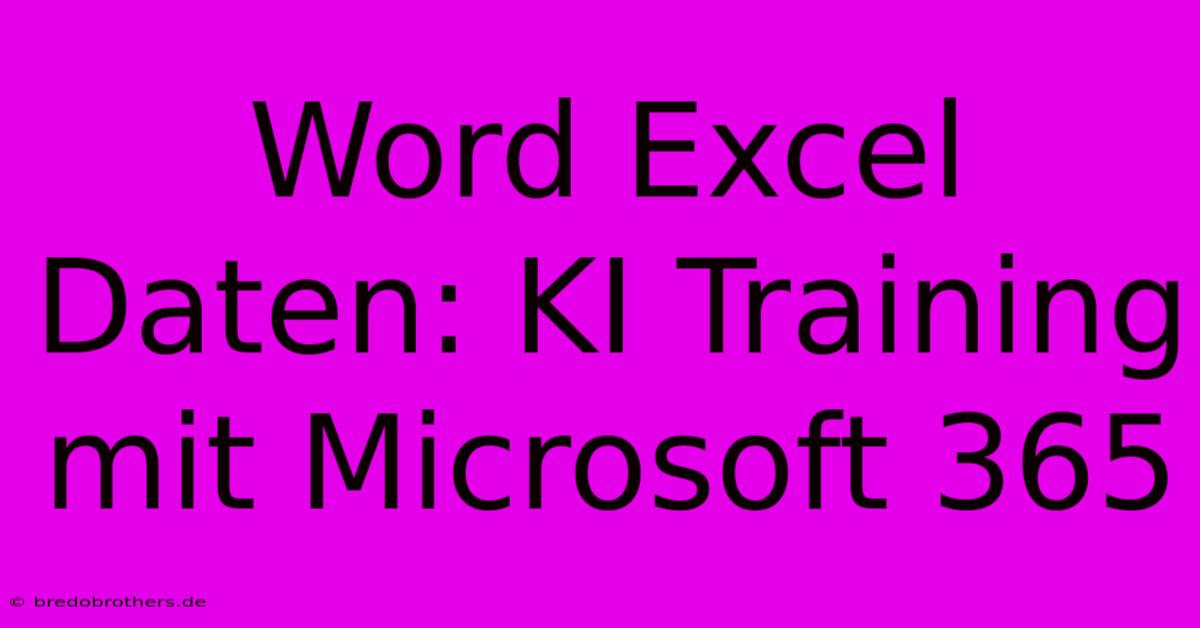Word Excel Daten: KI Training Mit Microsoft 365

Discover more detailed and exciting information on our website. Click the link below to start your adventure: Visit Best Website Word Excel Daten: KI Training Mit Microsoft 365. Don't miss out!
Table of Contents
Word & Excel Daten: KI Training mit Microsoft 365 – Meine ganz persönliche Erfahrung!
Hey Leute! Let's talk about something super cool, and maybe a little intimidating: KI Training mit Microsoft 365 Daten aus Word und Excel. I’ll be honest, when I first heard about using my Word documents and Excel spreadsheets to train AI, I thought, "Whoa, that's way over my head!" Turns out, it's not as scary as it sounds, but it definitely has its learning curve.
Meine anfängliche Skepsis (und ein paar lustige Fehler)
My initial attempts were, let's just say, interesting. I had this grand idea to use all my old project notes – think hundreds of Word docs crammed with random thoughts, data points, and half-baked ideas – to train a model that would magically predict future project timelines. Yeah, ambitious, right? The problem? My data was a total mess. I had inconsistent formatting, missing data, and, to be honest, some truly cryptic notes that probably only I could decipher. It was a recipe for disaster. The AI model? It basically threw its digital hands up in the air.
The biggest lesson I learned early on? Data cleaning is EVERYTHING. You can't just dump a bunch of raw data into an AI model and expect miracles. Think of it like baking a cake – you wouldn't just throw all the ingredients together and hope for the best, would ya?
Von Chaos zu Klarheit: Datenaufbereitung für KI-Training
So, I rolled up my sleeves and got to work. I started by standardizing my formats in both Word and Excel. This meant creating consistent headers, using the same units for measurements, and generally making everything as neat and tidy as possible. It was tedious, but totally worth it.
For my Excel spreadsheets, I focused on cleaning up inconsistencies in data types. Imagine trying to train an AI to predict sales figures, but some entries are text and others are numbers! It's a recipe for seriously wonky results. I used Excel's built-in data validation features to ensure consistency, and it made a huge difference.
Then came the hard part: dealing with missing data. I couldn't just ignore the gaps, so I had to decide how to handle them. Sometimes I could infer values from other data points; other times I had to remove the entire row. Choosing the right method depends on your dataset and the type of analysis you are doing. There's no one-size-fits-all answer, sadly.
Die Belohnung: Erfolg mit KI-Training
After weeks of painstaking data cleaning, guess what? My AI model actually started working! It wasn't perfect, and it still made mistakes, but it could provide reasonable estimations of project timelines. I even managed to predict a few potential roadblocks before they actually happened. It was seriously empowering!
Tipps für's KI-Training mit Word & Excel Daten:
- Planung ist alles: Before you even think about throwing data at an AI, plan your data structure carefully.
- Datenqualität ist König: Clean data is the foundation of effective AI training. Spend the time to get it right!
- Konsistenz ist der Schlüssel: Use consistent formats, units, and naming conventions in both Word and Excel. It'll save you so much heartache later.
- Experimentieren Sie: Try different methods for handling missing data and see what works best.
This whole process taught me so much about data analysis, AI training and the importance of good data hygiene. It wasn't always easy, but seeing my hard work pay off was incredibly rewarding. So, if you're thinking about using your Word and Excel data to train an AI, go for it! Just remember: cleaning your data is half the battle. And be prepared for some serious trial and error! Let me know how it goes for you!

Thank you for visiting our website wich cover about Word Excel Daten: KI Training Mit Microsoft 365. We hope the information provided has been useful to you. Feel free to contact us if you have any questions or need further assistance. See you next time and dont miss to bookmark.
Featured Posts
-
Only Fans Model Sophie Rain Einkommen
Nov 30, 2024
-
St Pauli Siegt Im Heimspiel
Nov 30, 2024
-
Schuldenbremse Selbstdisziplin Jetzt
Nov 30, 2024
-
Kellerkrimi Gewonnen St Pauli Siegt
Nov 30, 2024
-
Game Stop Aus Fuer Alle Filialen In De
Nov 30, 2024
